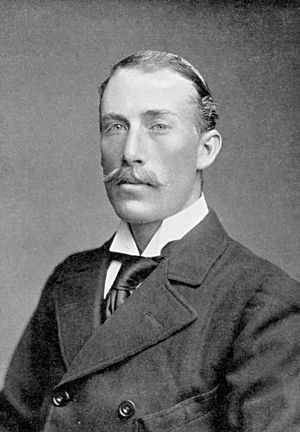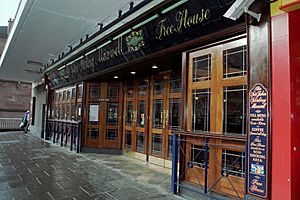Sir John Stirling-Maxwell, 10th Baronet facts for kids
Quick facts for kids
Sir John Stirling-Maxwell
|
|
|---|---|

Stirling-Maxwell in 1895
|
|
| Member of Parliament for Glasgow College |
|
| In office 1895–1906 |
|
| Preceded by | Sir Charles Cameron |
| Succeeded by | Henry Anderson Watt |
| Personal details | |
| Born |
John Maxwell Stirling-Maxwell
6 June 1866 London, England |
| Died | 30 May 1956 (aged 89) Pollok House, Glasgow, Scotland |
| Political party | Conservative |
| Spouse | Ann Christian Maxwell |
| Children | Anne Maxwell Macdonald, 11th Baronet |
| Alma mater | Eton College and Trinity College, Cambridge |
Sir John Maxwell Stirling-Maxwell, 10th Baronet, was an important Scottish landowner and politician. He was born on June 6, 1866, and passed away on May 30, 1956. He was also known for his kindness and for giving money to good causes, which is called being a philanthropist.
Contents
Who Was Sir John Stirling-Maxwell?
Sir John Stirling-Maxwell was a key figure in Scotland. He worked to protect natural spaces and art. He inherited his family's title, Baronet, in 1878. This title is passed down through families.
Early Life and Education
John was the oldest son of Sir William Stirling-Maxwell. His mother was Lady Anna Maria Leslie-Melville. He went to two famous schools. First, he studied at Eton College. After that, he attended Trinity College, Cambridge. These schools are well-known in England.
A Career in Public Service
Sir John was a Conservative Party politician. He served as a Member of Parliament (MP). An MP is someone elected to represent people in government. He represented the College Division of Glasgow. This was from 1895 to 1906.
He also held many other important roles:
- He was the Chairman of the Forestry Commission. This group looks after forests. He led it from 1929 to 1932.
- He was Chairman of the Royal Fine Art Commission for Scotland. This group advises on art.
- He was a Trustee of the National Galleries of Scotland. These galleries hold important art.
- He was Chairman of the Ancient Monuments Board. This board protects old buildings.
Sir John was also a member of the Royal Company of Archers. This is a ceremonial guard for the King. He was also active in Freemasonry, a social and charitable organization.
Protecting Green Spaces and Art
Sir John Stirling-Maxwell helped create the National Trust for Scotland in 1931. This organization works to protect Scotland's heritage. He believed that cities needed green spaces. He wanted to make sure people in Glasgow could enjoy the Pollok Estate. He opened it to the public in 1911.
He also worked to find a home for the art collection of Sir William Burrell. This collection was given to Glasgow in 1944. After Sir John's death, his daughter gave Pollok House to the city. She also gave a large part of the estate and her father's art. This gift helped the city build a museum for the Burrell Collection.
Honors and Recognition
In 1929, Sir John was made a Knight of the Thistle. This is a very high honor in Scotland. He also received special degrees from universities. These included the University of Glasgow and Edinburgh University. In 1902, he and his wife became Fellows of the Royal Horticultural Society. This society promotes gardening.
In 1938, he became a Fellow of the Royal Society of Edinburgh. This is a group of top scientists and thinkers. Sir John Stirling-Maxwell passed away at Pollok House on May 30, 1956.
His Family
On November 12, 1901, Sir John married Ann Christian Maxwell. They were married in Mochrum, Scotland. They had one daughter together. Her name was Dame Anne Maxwell Macdonald. She later inherited the Baronetess title.
Legacy
Sir John Stirling-Maxwell is remembered in Glasgow. There is a pub named after him in Shawlands. It is called the Sir John Stirling Maxwell pub. You can find it on Kilmarnock Road.


